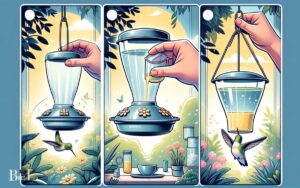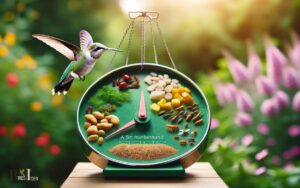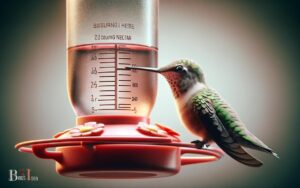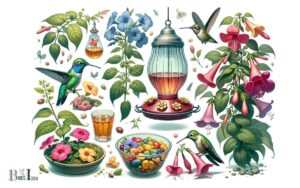How Often to Change Hummingbird Feeders? Every 2 to 4 Days!
For optimal health of hummingbirds, it is recommended to change hummingbird feeders every 2 to 4 days in cooler weather and daily in hot weather when temperatures exceed 90 degrees Fahrenheit.
The frequency of changing hummingbird feeders depends largely on the weather conditions:
These guidelines help prevent the growth of harmful bacteria and mold, which can proliferate in sugary solutions.
A visual inspection of the feeder for cloudiness or debris can also indicate it’s time for a change.
Maintaining clean feeders ensures the safety and return of your winged guests, making your garden a vibrant hummingbird haven.

Key Takeaway
Importance of Clean Feeders
Maintaining clean feeders is crucial for ensuring the health and well-being of hummingbirds. Cleanliness is essential in preventing the growth of harmful bacteria and mold, which can have detrimental effects on the delicate systems of these tiny birds.
Regular cleaning, using a solution of one-part white vinegar to four parts water, is recommended to keep feeders free from contamination.
Not only does this practice benefit the hummingbirds, but it also demonstrates a commitment to their welfare, aligning with the ethos of serving and caring for these creatures.
By maintaining clean feeders, individuals contribute to the overall well-being of the hummingbird population, creating a safe and inviting environment for these remarkable birds to thrive and flourish.
Signs It’s Time to Change
As a responsible caretaker of hummingbird feeders, it’s crucial to be attentive to signs that indicate when it’s time to change the nectar.
Mold or mildew formation in the feeder, a cloudy or discolored appearance of the nectar, and a decrease in hummingbird activity around the feeder are all key indicators that the nectar needs to be refreshed.
Recognizing these signs and promptly replacing the nectar will help maintain a healthy and inviting environment for these delightful avian visitors.
Mold or Mildew
When mold or mildew is present in the hummingbird feeder, it is time to change it. Mold and mildew pose health risks to hummingbirds and can contaminate the nectar, leading to illness or even death.
To ensure the well-being of the hummingbirds and maintain a healthy feeding environment, it is crucial to recognize the signs of mold or mildew in the feeder:
- Visible Growth: Check for any visible signs of mold or mildew inside the feeder, such as dark spots or fuzzy patches.
- Unpleasant Odor: If the nectar or feeder emits a musty or unpleasant smell, it may indicate the presence of mold or mildew.
- Cloudy Nectar: Mold or mildew can cause the nectar to become cloudy or discolored, signaling contamination and the need for immediate replacement.
Regular inspection and prompt action can help prevent potential harm to the hummingbirds.
Cloudy or Discolored
Upon observing cloudy or discolored nectar in the hummingbird feeder, it is imperative to promptly replace the nectar to maintain a healthy feeding environment and ensure the well-being of the hummingbirds.
Cloudy or discolored nectar is a sign that the nectar has begun to ferment or grow mold, which can be harmful to the hummingbirds. This can lead to digestive issues and impact their overall health.
To prevent any potential harm, it is recommended to clean the feeder thoroughly and refill it with fresh nectar every 2-3 days, especially in warmer weather.
Regular maintenance and observation of the nectar’s quality are essential to guarantee that the hummingbirds are receiving a safe and nutritious food source.
By staying attentive to these signs, you can provide a welcoming environment for these beautiful creatures.
Decreased Hummingbird Activity
After noticing decreased hummingbird activity around the feeder, it may be a sign that it’s time to change the nectar.
Hummingbirds are attracted to fresh nectar, and a decline in their visits could indicate that the nectar has gone bad.
Here are three signs to look out for:
- Empty Feeder: If the feeder remains full for an extended period, it suggests that the hummingbirds are not consuming the nectar, possibly due to its quality.
- Unsipped Nectar: Check for unsipped or untouched nectar in the feeder. Hummingbirds typically sample the nectar soon after it’s refilled. If it remains untouched, it may be time to change it.
- Increased Insect Activity: Stagnant nectar can attract ants and other insects, deterring hummingbirds. If you notice a surge in insect activity around the feeder, it’s a clear indication that the nectar needs to be replaced promptly.
Recommended Frequency
The recommended frequency for changing hummingbird feeders is every 2-3 days to ensure the freshness and safety of the nectar.
This regular maintenance prevents the growth of mold and bacteria, which can be harmful to the hummingbirds.
By keeping the nectar fresh, you are providing a safe and healthy environment for these beautiful creatures.
It’s important to establish a routine for cleaning and refilling the feeders to support the well-being of the hummingbirds that rely on them.
| Task | Frequency |
|---|---|
| Clean feeder | Every 2-3 days |
| Refill with fresh nectar | Every 2-3 days |
| Check for mold | Every 2-3 days |
| Inspect feeder parts | Weekly |
| Deep clean | Monthly |
Steps for Cleaning
Now that we’ve covered the recommended frequency for changing hummingbird feeders, it’s important to discuss the crucial steps for cleaning.
This includes understanding the proper cleaning frequency and the recommended cleaning methods to ensure the health and safety of the hummingbirds.
Let’s address these key points to maintain a clean and inviting environment for these beautiful creatures.
Proper Cleaning Frequency
Hummingbird feeders should be cleaned thoroughly every three to five days to prevent mold and bacteria growth.
Proper cleaning frequency is essential to maintain the health and well-being of the hummingbirds that visit your feeder.
Follow these steps for effective cleaning:
- Disassemble the feeder: Carefully take apart the feeder, including removing the perches, ports, and any other removable parts.
- Wash with hot water and soap: Use a mild soap and hot water to thoroughly clean all parts of the feeder, including hard-to-reach areas. Consider using a small brush to scrub the inside of the feeder.
- Rinse and dry: After cleaning, rinse the feeder with clean water and allow it to air dry completely before refilling it with fresh nectar. Ensure there is no soap residue left behind, as it can be harmful to hummingbirds.
Recommended Cleaning Methods
Effective cleaning of hummingbird feeders involves thorough disassembly, hot water and soap wash, and complete drying to ensure a safe and inviting environment for the visiting birds.
Start by carefully disassembling the feeder, removing all parts including the perches, feeding ports, and any decorative elements.
Wash each part with hot water and a mild dish soap, using a bottle brush to scrub the interior of the feeder.
Rinse thoroughly to remove all soap residue. Allow all parts to completely air dry before reassembling the feeder.
It’s important to ensure that no moisture is trapped inside the feeder, as this can lead to mold or bacterial growth.
Following these steps will help maintain a clean and healthy environment for the hummingbirds that frequent your feeder.
Choosing the Right Time
When determining the right time to change hummingbird feeders, consider the local climate and bird activity levels.
This will help ensure that the nectar remains fresh and uncontaminated, providing the best nutritional value for the hummingbirds visiting your feeder.
To choose the right time to change hummingbird feeders:
- Weather Conditions: Keep an eye on the weather forecast. In hot and humid climates, nectar can spoil more quickly, requiring more frequent changes. In cooler climates, the nectar may last longer.
- Bird Activity: Monitor the frequency of hummingbird visits to your feeder. If there is high bird activity, the nectar will likely need to be changed more often to maintain its freshness.
- Regular Inspections: Regularly inspect the feeder and nectar for signs of spoilage, such as cloudiness or mold growth, and change it as needed.
Impact on Hummingbird Health
Regularly monitoring the condition of the nectar and changing it as needed is crucial for maintaining the health of hummingbirds.
The table below outlines the potential impacts on hummingbird health based on the condition of the nectar in the feeders.
| Nectar Condition | Impact on Hummingbird Health | Action Required |
|---|---|---|
| Fresh and Clean | Optimal health | Continue regular maintenance |
| Cloudy or Discolored | Risk of illness | Clean and replace nectar |
| Moldy or Spoiled | Severe health risks | Clean feeder thoroughly |
Extending Feeder Lifespan
To prolong the lifespan of hummingbird feeders, it is essential to implement proper cleaning and maintenance routines to ensure the health and well-being of the hummingbird community.
Here are three key practices to extend the feeder lifespan:
- Regular Cleaning: Clean the feeder at least every 3-4 days, especially in warm weather, to prevent mold and bacteria growth that could harm the hummingbirds.
- Use of Mild Detergents: When cleaning the feeder, use a mild detergent and a bottle brush to thoroughly remove any residue or build-up.
- Inspection and Repair: Regularly inspect the feeders for any signs of wear and tear, such as cracks or fading, and make necessary repairs or replacements to maintain their functionality and safety for the hummingbirds.
How Often to Clean Hummingbird Feeders?
Cleaning hummingbird feeders regularly is crucial to ensure the health of the hummingbirds that visit and prevent the growth of harmful mold and bacteria in the nectar.
Here are some general guidelines:
- Frequency: In warm weather, it’s recommended to clean your hummingbird feeder every 2 to 3 days. In cooler weather, you can extend the cleaning interval to about once a week.
- Inspect Before Refilling: Before refilling the feeder, inspect it for any signs of mold, discoloration, or debris. If you notice any, clean the feeder thoroughly.
- Use Hot Water: When cleaning, use hot water to rinse and scrub the feeder. Avoid using soap or detergent, as residue can be harmful to hummingbirds.
- Brushes: Invest in a small brush designed for hummingbird feeders to clean the nooks and crannies effectively. These brushes are designed to reach the interior of the feeder tubes.
- Deep Cleaning: Perform a deep clean with a vinegar solution every two weeks or as needed. Mix one part white vinegar to four parts water and soak the feeder in this solution for an hour. Rinse thoroughly with hot water afterward.
- Replace Nectar: Besides cleaning the feeder, replace the nectar regularly. In hot weather, nectar may spoil more quickly, so it’s essential to monitor and refill as needed.
- Shade Placement: Consider placing your hummingbird feeder in a shaded area. Direct sunlight can cause the nectar to spoil more quickly, leading to more frequent cleanings.
- Monitor Hummingbird Activity: Keep an eye on hummingbird activity. If you notice a decrease in visits, it might be a sign that the nectar has spoiled, and the feeder needs cleaning.
Regular cleaning helps ensure that the hummingbirds have access to fresh, uncontaminated nectar. Keeping the feeder clean also prevents the growth of harmful pathogens that can be detrimental to the health of the birds.
How Often Should I Change the Nectar in My Hummingbird Feeder?
Hummingbird feeders should have their nectar changed regularly to maintain the bird’s health. Experts recommend putting out a hummingbird feeder for every two to three days during cooler weather and every one to two days in hot temperatures. This ensures the nectar remains fresh and prevents fermentation, which can be harmful to the tiny birds.
What Happens If You Don’t Change Hummingbird Feeder?
If you don’t regularly clean and change the nectar in a hummingbird feeder, several issues can arise:
Mold and Bacteria Growth
The sugar water (nectar) in hummingbird feeders can become a breeding ground for mold and bacteria.
This can be harmful to hummingbirds, as they may consume contaminated nectar, leading to health problems.
Fermentation
Over time, the sugar in the nectar can ferment, producing alcohol. Consuming fermented nectar can be harmful to hummingbirds, as they are not adapted to metabolize alcohol.
Insects and Pests
Stagnant nectar can attract insects, such as ants and bees, which can make the feeder less appealing to hummingbirds. In extreme cases, the feeder may become infested with pests.
Degradation of Nectar Quality
Exposure to sunlight and heat can cause the nectar to break down and lose its nutritional value.
Hummingbirds rely on the energy provided by the nectar, so if it becomes less nutritious, it may negatively impact their health.
To maintain a healthy and attractive environment for hummingbirds, it’s important to clean the feeder regularly and change the nectar at least every few days, especially in warm weather.
Cleaning involves thoroughly rinsing the feeder with hot water and using a small brush to remove any residue.
If you notice signs of mold or discoloration in the nectar, it’s crucial to clean the feeder immediately and replace the nectar. Placing the feeder in a shaded area can help slow down the degradation of the nectar.
Conclusion
It is crucial to regularly clean and change hummingbird feeders to ensure the health and well-being of the hummingbirds.
By monitoring for signs of spoilage and adhering to the recommended frequency for changing feeders, individuals can help maintain a safe and hygienic feeding environment.
This proactive approach not only benefits the hummingbirds but also extends the lifespan of the feeders, ultimately making it a win-win situation for both humans and nature. As the saying goes, “a stitch in time saves nine.”
“A stitch in time saves nine,” meaning that taking care of something promptly can prevent a much larger problem later on.






